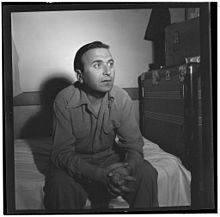- Charlie Spivak
-
Charlie Spivak (17 February 1905 or 1907–1 March 1982) was an American trumpeter and bandleader, best known for his big band in the 1940s.
Contents
Biography
The details of Spivak's birth are unclear. Some sources place it in the Ukraine in 1907, and that his family emigrated to settle in New Haven, Connecticut while he was a child. Others place his birth in New Haven two years earlier, in 1905. What is certain is that he learned to play trumpet when he was ten years old, and played in his high school band, going on to work with local groups before joining Johnny Cavallaro's orchestra.
He played with Paul Specht's band for most of 1924 to 1930, then spent time with Ben Pollack (1931–1934), the Dorsey brothers (1934–1935), and Ray Noble (1935– 1936). He played on "Solo Hop" in 1935 by Glenn Miller and His Orchestra. He spent 1936 and 1937 mostly working as a studio musician with Gus Arnheim, Glenn Miller, Raymond Scott's radio orchestra, and others, followed by periods with Bob Crosby (1938), Tommy Dorsey (1938–1939), and Jack Teagarden (1939).
Finally, with the encouragement and financial backing of Glenn Miller, he formed his own band in November 1939.[1] Though it failed within a year, he tried again shortly afterwords, this time taking over an existing band (Bill Downer's) and making a success of it. Spivak's band was one of the most successful in the 1940s, and survived until 1959. He scouted top trumpeter Paul Fredricks (formerly of Alvino Rey's Orchestra) just as Fredricks left the service at the end of the War in 1946. Fredricks was instrumental in the band's success in the coming years as it reached its peak [2].
Spivak's experience playing with jazz musicians had little effect on his own band's style, which was straight dance music, made up mainly of ballads and popular tunes. Spivak himself (known as "Cheery, Chubby Charlie") had always been noted and used for his tone rather than for any improvisational ability.
A number of the band's musicians were to make names for themselves, including drummer Dave Tough, bassist Jimmy Middleton, trumpeters Les Elgart and Paul Fredricks, saxophonist Don Raffell, trombonist Nelson Riddle, and singers Garry Stevens, June Hutton, Tommy Mercer, Jimmy Saunders, and Irene Daye (who had sung with Gene Krupa, and whom Spivak married in 1950). Riddle was also responsible for many of the band's arrangements, together with Sonny Burke. The late Manny Albam also arranged for the Spivak band.
When the Spivak orchestra broke up, he went to live in Florida, where he continued to lead a band until illness led to his temporary retirement in 1963. On his recovery, he continued to lead large and small bands, first in Las Vegas, then in South Carolina; in Greenville, South Carolina in 1967 he led a small group featuring his wife as vocalist. She died in 1971 after years of fighting cancer. During this time Spivak was also co-owner of the "Ye Olde Fireplace Inn", a dinner club in Greenville. Spivak continued to play and record until his death. Spivak's son, Joel A. Spivak, was a television and radio broadcaster primarily in the Philadelphia, Pa, Los Angeles, Cal, and Washington, DC areas.
Discography
- 1958: Pinciana (Design)
- 1977: Charlie Spivak and his Orchestra 1943-46 (Hindsight)
- 1985: Charlie Spivak and his Orchestra (Ranwood)
- 1993: For Sentimental Reasons (Vintage Jazz Classics)
- 2002: Dance Date (Collectors' Choice Music)
- 2005: What's Cookin' Charlie '41 - '47
References
External links
- Charlie Spivak — biography from Solid!
- Charlie Spivak at Find a Grave
Categories:- 1900s births
- 1982 deaths
- American trumpeters
- Jewish American musicians
- American bandleaders
- Year of birth uncertain
Wikimedia Foundation. 2010.

